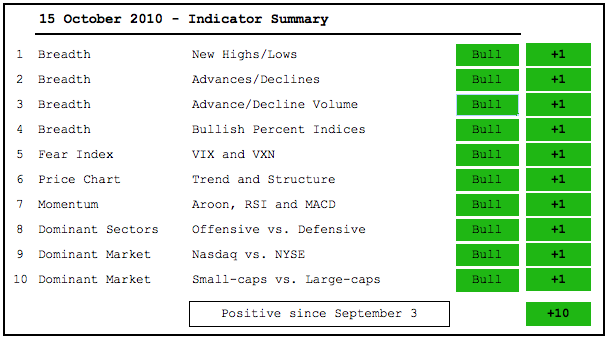With a breakout in the Nasdaq AD Line, all ten indicators are now in bull mode. This indicator summary has been positive since September 3rd, going on six weeks now. DIA and QQQQ are challenging their April highs, but the Finance SPDR (XLF) remains below its summer highs. Once again, the finance sector is the big holdout here. Despite relative weakness in finance, there is plenty of strength elsewhere to keep the market in bull mode overall. The only concern is the overbought condition that increase the odds for a pullback or correction.
- AD Lines: Bullish. The NYSE AD Line hit a new 52-week high again this week (bullish), and the Nasdaq AD Line finally broke its summer high (bullish).
- AD Volume Lines: Bullish. The NYSE AD Volume Line moved sharply higher the last three weeks (bullish) and the Nasdaq AD Volume Line continued higher with a consolidation breakout (bullish).
- Net New Highs: Bullish. Nasdaq Net New Highs have been positive since early September and NYSE Net New Highs have been positive since late August (bullish).
- Bullish Percent Indices: Bullish. Except for the finance sector, once again, all index and sector Bullish Percent Indices are above 50%.
- VIX/VXN: Bullish. The S&P 500 Volatility Index ($VIX) and Nasdaq 100 Volatility Index ($VXN) remain in downtrends. Falling volatility means lower risk, which is bullish for stocks.
- Trend Structure: Bullish. QQQQ, SPY, DIA and IWM are all trading above their summer highs (bullish).
- SPY Momentum: Bullish. MACD(5,35,5) and Aroon (20) moved into positive territory the second week of September and RSI surged above 60.
- Offensive Sector Performance: Bullish. Finance remains the big laggard, but tech, consumer discretionary and industrials are leading. 3 out of 4 are in bull mode.
- Nasdaq Performance: Bullish. The $COMPQ:$NYA ratio bounced over the last two weeks and remains in an uptrend since early September (bullish).
- Small-cap Performance: Bullish. The $RUT:$OEX ratio has been moving higher since mid August with a series of higher highs and higher lows.
- Breadth Charts have been updated (click here)
-----------------------------------------------------------------------------
This commentary and charts-of-interest are designed to stimulate thinking. This analysis is not a recommendation to buy, sell, hold or sell short any security (stock ETF or otherwise). We all need to think for ourselves when it comes to trading our own accounts. First, it is the only way to really learn. Second, we are the only ones responsible for our decisions. Think of these charts as food for further analysis. Before making a trade, it is important to have a plan. Plan the trade and trade the plan. Among other things, this includes setting a trigger level, a target area and a stop-loss level. It is also important to plan for three possible price movements: advance, decline or sideways. Have a plan for all three scenarios BEFORE making the trade. Consider possible holding times. And finally, look at overall market conditions and sector/industry performance.







